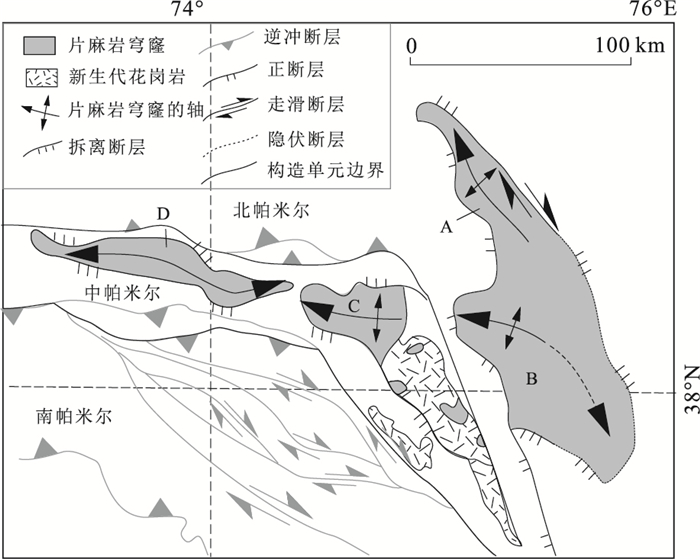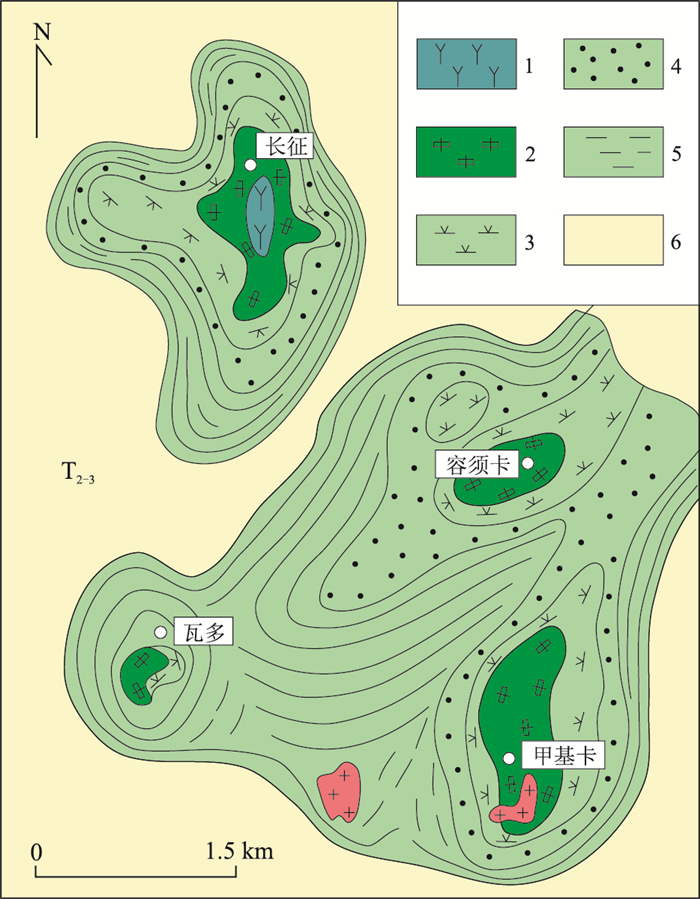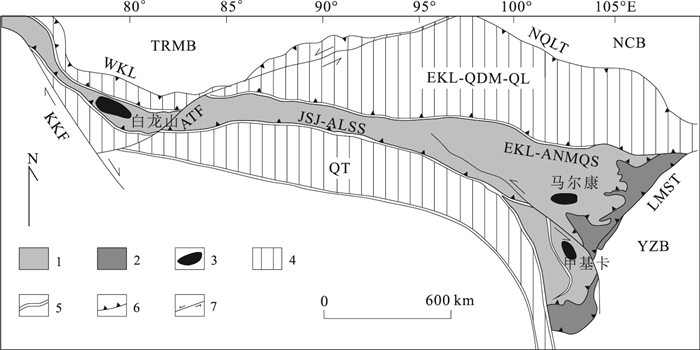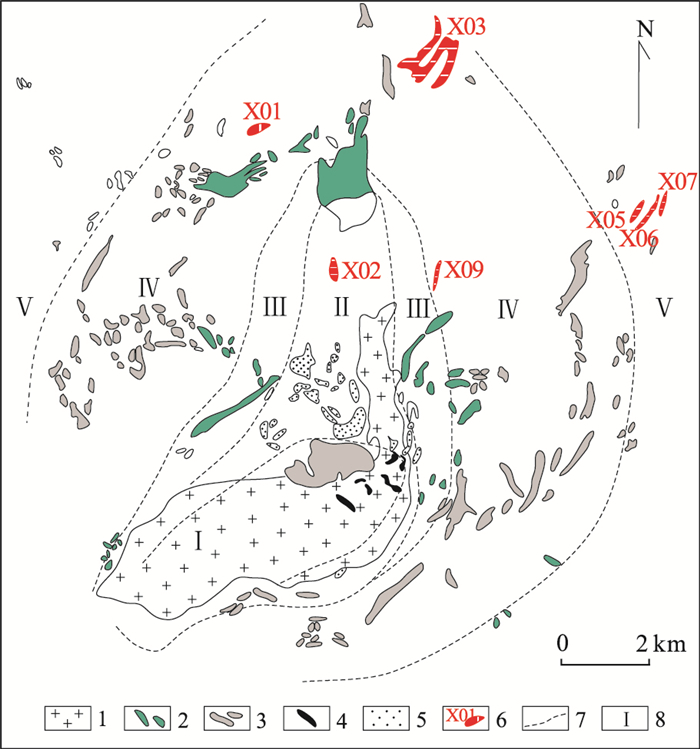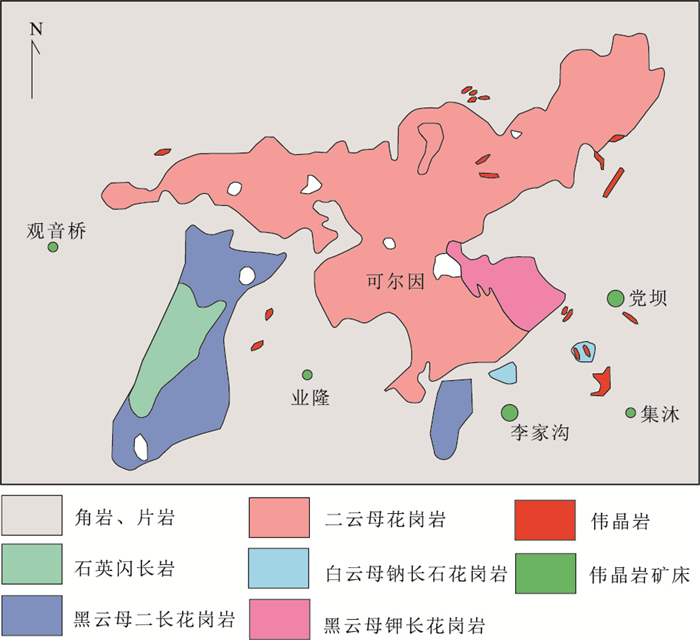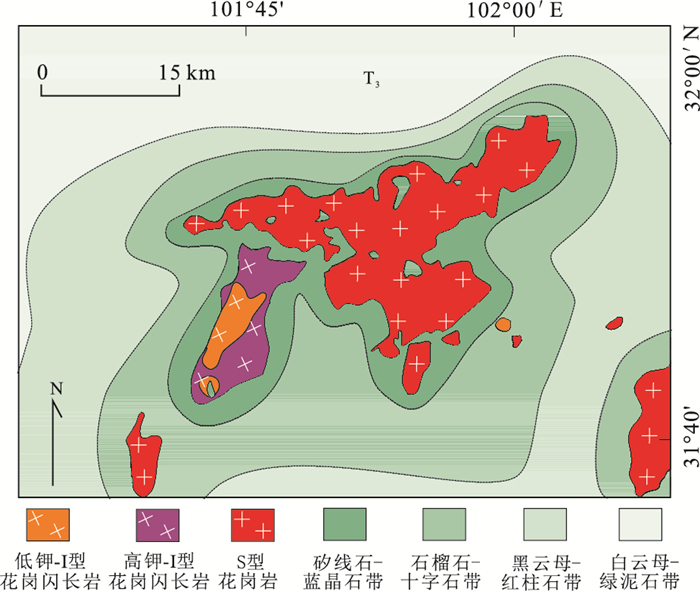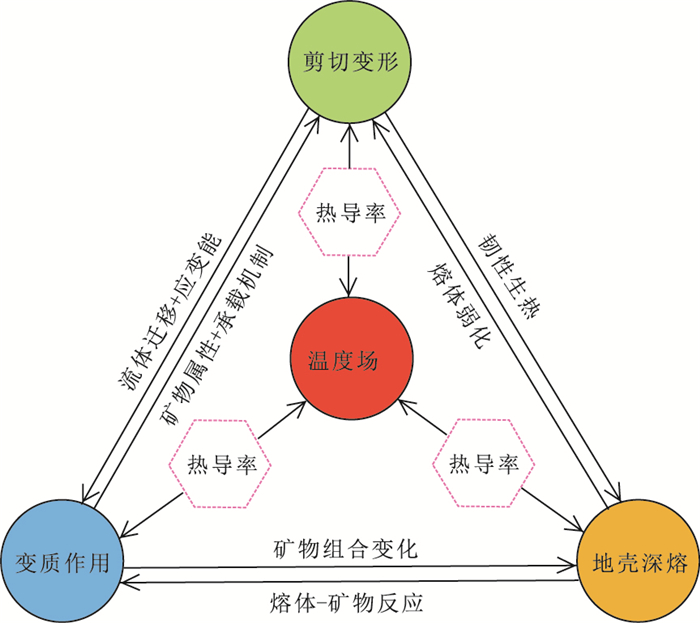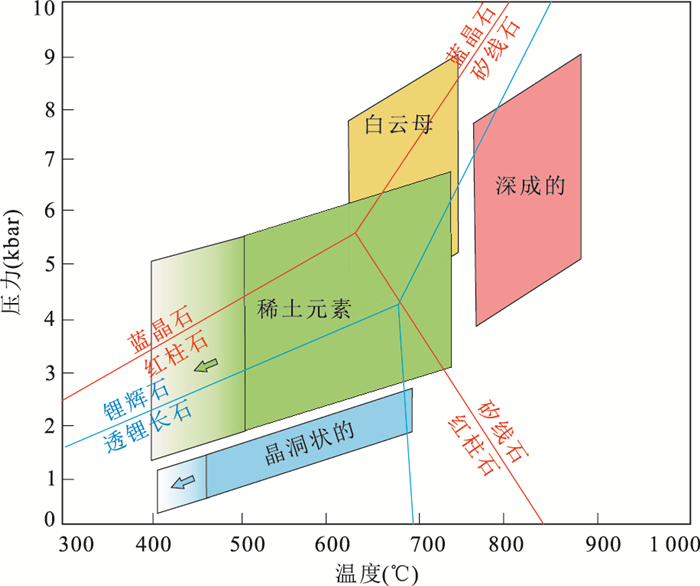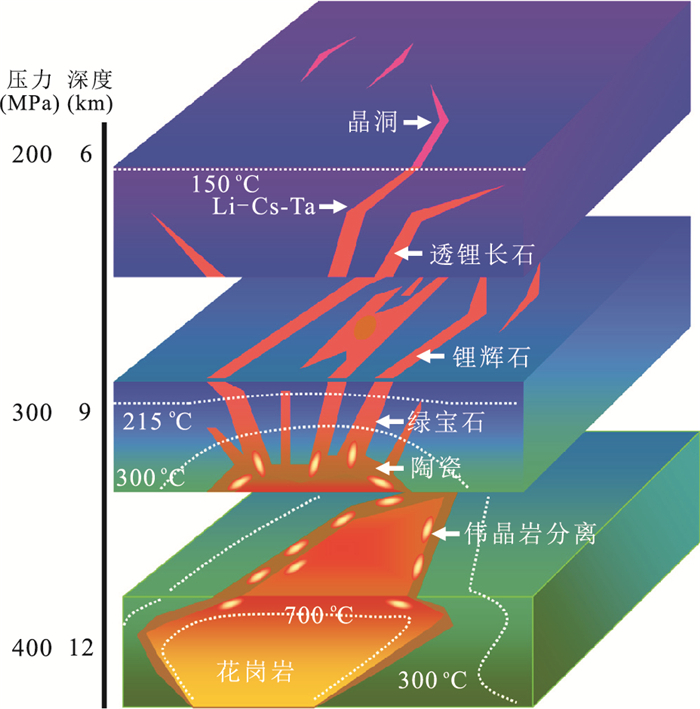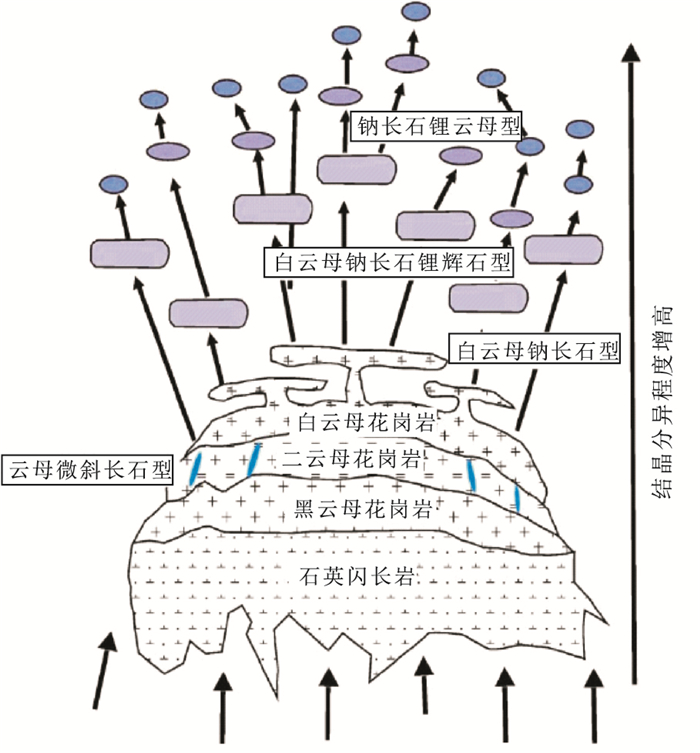Discussion on Relationships of Gneiss Dome and Metallogenic Regularity of Pegmatite-Type Lithium Deposits
-
摘要: “片麻岩穹窿”是指中下地壳热动力过程产生的与岩浆作用(或混合岩化作用)密切相关的穹状构造,是折返造山的产物.片麻岩穹窿的形成经历了从垂直上升的地壳流导致的岩浆上涌的挤压收缩到岩体侵位的顶部伸展机制的转化过程,这一过程有利于富含锂-铯-钽型(LCT)型伟晶岩的生成和锂族元素的富集.研究表明,位于青藏高原北部的中国松潘-甘孜-甜水海印支造山带是中国大型"伟晶岩型"锂矿资源赋存的基地,松潘-甘孜东南部的超大型甲基卡型伟晶岩型锂矿带,产于具有巴罗式"低/中压-高温"变质组合的三叠纪复理石围岩中,早中生代花岗岩以及衍生的大量含锂稀土矿物的伟晶岩脉侵位有成因关系.研究认为,探究片麻岩穹窿的形成过程和构造成因机制;识别花岗岩-含矿伟晶岩的地球化学属性,揭示花岗岩浆分异作用与含矿伟晶岩相演变的成因联系,以及锂元素迁移、富集熔浆的过程;圈定三叠纪地层中巴罗式变质相带的展布,探明富锂伟晶岩矿带赋存的有利变质相带及形成的P-T条件;揭示"变形-变质-岩浆深熔-成矿"的时空耦合、制约与相互作用,再造造山过程中锂资源富集和保存的规律,以及建立成矿动力学模式;是揭示片麻岩穹窿与伟晶岩型锂矿的成矿规律的重要科学途径.Abstract: Gneiss domes develop in exhuming orogens, where they constitute an efficient mechanism for material and heat advection of continental crust during orogenesis, which is always related to magmatism (or migmatization). Dome formation may be accompanied by heterogeneous thinning of the upper crust that may occur as the ductile lower crust flows into a gneiss dome by convergent flow and lead to contraction strain in the core. During gneiss dome formation process, lithium-rich (with other rare earth elements) pegmatite is beneficial to form and hence, lead to lithium enrichment. Previous researches indicate that the Songpan-Ganzi-Tianshuihai Indosinian orogenic belt, located in the northern part of the Qinghai-Tibetan Plateau, is the "pegmatite-type" lithium mine resources base in China. The ultra-large pegmatite-type lithium belt in the southwestern of the Songpan-Ganzi occurs in the Triassic flysch which is the country rock of Barrow-type metamorphism with low/medium pressure-high temperature metamorphic traits. It has a genetic relationship with the Late Triassic granite and the lithium-bearing pegmatite intrusion. The authors suggest that future studies should focus on (1) exploring the formation process and tectonic mechanism of gneiss domes; (2) identifying the geochemical properties of granite-bearing pegmatites; (3) revealing the genetic relationship between the differentiation of granite and the evolution of ore-bearing pegmatite; (4) clarifying lithium migrating and enriching process in the melt; (5) delineating the distribution of the Barrow-type metamorphic facies belt in the Triassic strata; (6) proving the favorable metamorphic facies belts and P-T conditions where the lithium-rich pegmatite formed can reveal the space-time coupling of "deformation-metamorphism-magmatic deep-melting-metallogenesis". Moreover, the law of enrichment and preservation of lithium ore, used to establish the metallogenic kinetics model, is an important scientific aspect to reveal the relationships of gneiss dome and metallogenic regularity of pegmatite-type lithium deposits.
-
0. 引言
片麻岩穹窿(Eskola, 1948)是造山折返的产物(Vanderhaeghe, 2004; Whitney et al., 2004).绝大部分片麻岩穹窿的构造组合从里到外可以分为核、边和幔3部分,核部为花岗岩和深熔混合岩,边部为花岗片麻岩,幔部典型特征是以高级变质沉积岩和变质火山岩为标志的高角闪岩到麻粒岩相片麻岩(或者高温片岩) (Whitney et al., 2004),也被简化为核部(例如混合岩和花岗质岩体)和上覆的变质层(例如边部的片岩和片麻岩)的双层构造(Stübner et al., 2013).在幔部变质岩中,发育从片麻岩穹窿顶部向两侧下滑的典型层叠式褶皱(Cascading folds)(图 1)(Burg et al., 2004),反映片麻岩穹窿以全熔岩或花岗质岩石为主的核部,由于岩石的部分熔融作用产生的流动及褶皱效应.在一些片麻岩穹窿的深部,流动面理通道以漏斗状为主,在地表则以穹窿状为主,并且多数情况下在大的片麻岩穹窿内部或边缘会有次级的片麻岩穹窿体出露, 或多个片麻岩穹窿呈线状或面状成群出露(Lagarde et al., 1994; Arnold et al., 1995; Vanderhaeghe et al., 1999; Fisher and Olsen, 2004; Gervais et al., 2004; Ayarza and Martínez Catalán, 2007),如北-中帕米尔片麻岩穹窿群由空喀山、慕孜塔格、Yazgulom和Muskol片麻岩穹窿组成(图 2)(Schmidt et al., 2011),松潘-甘孜造山带中雅江片麻岩穹窿群包含长征、容须卡、甲基卡和瓦多4个片麻岩穹窿(许志琴等,1992),以及马尔康片麻岩穹窿群包含可尔因和太阳河片麻岩穹窿(de Sigoyer et al., 2014; Zhao et al., 2019);北喜马拉雅的拉轨岗日片麻岩穹窿群包含雅拉香波-马波加-康马-普弄抗日-萨加-马拉山-错那洞等多个片麻岩穹窿(张金阳等,2003;Guo et al., 2008; 高利娥等,2011;辜平阳等,2013;董汉文等,2018).
 图 1 片麻岩穹窿的结构示意据Whitney et al.(2004);核部为混合岩化的花岗岩,边部为花岗片麻岩,幔部为变质岩和层叠褶皱;箭头代表剪切指向Fig. 1. Schematic diagram of the structure of gneiss dome
图 1 片麻岩穹窿的结构示意据Whitney et al.(2004);核部为混合岩化的花岗岩,边部为花岗片麻岩,幔部为变质岩和层叠褶皱;箭头代表剪切指向Fig. 1. Schematic diagram of the structure of gneiss dome 图 2 北-中帕米尔片麻岩穹窿群示意据Schmidt et al.(2011);A.空喀山穹窿;B.慕孜塔格穹窿;C.Yazgulom穹窿;D.Muskol穹窿Fig. 2. Schematic diagram of the North-Central Pamir gneiss dome group
图 2 北-中帕米尔片麻岩穹窿群示意据Schmidt et al.(2011);A.空喀山穹窿;B.慕孜塔格穹窿;C.Yazgulom穹窿;D.Muskol穹窿Fig. 2. Schematic diagram of the North-Central Pamir gneiss dome group片麻岩穹窿幔部的变质岩有很好的分带性和规律性.如中国松潘-甘孜造山带位于三叠系西康群中的“雅江”和“马尔康”地区片麻岩穹窿(图 3),以及喜马拉雅片麻岩穹窿群.片麻岩穹窿的幔部变质岩由内而外分别为矽线石带、十字石带、红柱石带、石榴石带、黑云母带和绢云母-绿泥石带的巴罗式变质分带(许志琴等,1992; Guo et al., 2008;辜平阳等,2013;付小方等,2017;董汉文等,2018; Zhao et al., 2019).这说明中压Barrovian式变质分带是片麻岩穹窿幔部变质的主要特点.
 图 3 松潘-甘孜造山带雅江片麻岩穹窿群分布据许志琴等(1992);1.矽线石带;2.十字石带;3.红柱石带;4.石榴石带;5.黑云母带;6.花岗岩Fig. 3. Distribution of the Yajiang gneiss dome group in the Songpan-Ganzi orogenic belt
图 3 松潘-甘孜造山带雅江片麻岩穹窿群分布据许志琴等(1992);1.矽线石带;2.十字石带;3.红柱石带;4.石榴石带;5.黑云母带;6.花岗岩Fig. 3. Distribution of the Yajiang gneiss dome group in the Songpan-Ganzi orogenic belt片麻岩穹窿的形成经历了从垂直上升的地壳流导致的岩浆上涌的挤压收缩到岩浆体侵位的顶部伸展机制的转化过程(Whitney et al., 2004), 这一过程将有利于大量富含稀土的伟晶岩脉的侵位和锂元素的富集.瑞典化学家阿·阿尔夫维特桑在1817年发现的锂(Li)金属是地球上最轻的银白色金属,为什么当今富含稀土金属元素的锂(铍铌钽铯铷)资源会引起人们极大的兴趣和重视?因为它已经从普通的矿产资源变成“能源金属”和“高能金属”(许志琴和马绪宣, 2015).锂资源的开发利用贯穿节能环保、新一代信息技术、高端装备制造、新材料和新能源汽车等产业,也被广泛应用于原子能工业、电子、化学、冶金、宇航等领域,具有非常重要的经济和战略意义.
最近的探测和研究表明,川西雅江的甲基卡、马尔康的李家沟和新疆喀喇昆仑的白龙山超大型锂矿带,展布在青藏高原北部横跨2 800 km的巨型(松潘-甘孜-甜水海)造山带中,将成为我国未来新能源发展的重要后备基地(图 4).该巨型锂矿带就是赋存于巴罗式变质的三叠纪复理石地层、印支期花岗岩与含锂的伟晶岩脉相伴的片麻岩穹窿构造样式中(图 2;许志琴等,1992;许志琴和马绪宣, 2015).甲基卡矿床是目前亚洲规模最大的固体锂矿床,规模大、品位高、矿种多、埋藏浅、选矿性能好.预测远景资源量达500×104 t,铍、铌、钽、铯可综合利用,具有广阔的开发前景(黄韬等,2018).
 图 4 位于青藏高原北部的松潘-甘孜-甜水海地体位置1.松潘-甘孜-甜水海造山带的三叠系;2.松潘-甘孜造山带中新元古代-古生代地层;3.锂矿带位置;4.周围地体;5.缝合带;6.逆冲断裂;7.走滑断裂;TRMB.塔里木盆地;WKL.西昆仑;KKF.喀喇昆仑断裂;NCB.北中国陆块;NQLT.北祁连逆冲断裂;EKL-QDM-QL.东昆仑-柴达木-祁连地体;EKL-ANMQS.东昆仑-阿尼玛卿缝合带;JSJ-ALSS.金沙江-哀牢山缝合带;QT.羌塘地体;LMST.龙门山逆冲断裂;YZB.扬子陆块Fig. 4. Location of the Songpan-Ganzi-Tianshuihai terrane in the northern part of the Qinghai-Tibet Plateau
图 4 位于青藏高原北部的松潘-甘孜-甜水海地体位置1.松潘-甘孜-甜水海造山带的三叠系;2.松潘-甘孜造山带中新元古代-古生代地层;3.锂矿带位置;4.周围地体;5.缝合带;6.逆冲断裂;7.走滑断裂;TRMB.塔里木盆地;WKL.西昆仑;KKF.喀喇昆仑断裂;NCB.北中国陆块;NQLT.北祁连逆冲断裂;EKL-QDM-QL.东昆仑-柴达木-祁连地体;EKL-ANMQS.东昆仑-阿尼玛卿缝合带;JSJ-ALSS.金沙江-哀牢山缝合带;QT.羌塘地体;LMST.龙门山逆冲断裂;YZB.扬子陆块Fig. 4. Location of the Songpan-Ganzi-Tianshuihai terrane in the northern part of the Qinghai-Tibet Plateau伟晶岩型锂矿的形成具有独特的物理、化学形成条件.尽管在伟晶岩的成分分带、新矿物的发现、地球化学的演化与稀有金属的富集机制、熔体-流体的来源与结晶分异、成岩成矿的物理化学条件等研究方面已经取得了重要进展,但是,在造山过程中“岩浆-变形-变质-成矿”四位一体的片麻岩穹窿的形成机制,与伟晶岩型锂矿成矿规律的关系,以及对于伟晶岩及其相关成矿作用发生的地球动力学背景研究,依然没有根本解决,成为大陆动力学研究的重要前沿和探索课题.这一研究不仅可以提供学科发展和交叉的最佳窗口,而且为找矿突破提供科学依据,具有重要的科学意义和实用价值.
1. 川西片麻岩穹窿与伟晶-花岗岩型锂矿床
松潘-甘孜造山带是三叠纪末-早侏罗世时期大规模的印支造山运动的产物.研究表明其与早中三叠世古特提斯洋盆(昆仑-阿尼玛卿和金沙-理塘洋盆)的双向俯冲有关(许志琴等, 1992; Roger et al., 2010; de Sigoyer et al., 2014).印支造山作用表现为巨量的三叠纪复理石沉积构造楔的形成(Mattauer et al., 1992)、大量228~195 Ma同造山花岗岩体(Zhang et al., 2006, 2007; Xiao et al., 2007; Yuan et al., 2010)以及后造山花岗岩的侵位.目前发现的雅江甲基卡和马尔康李家沟的大型-特大型“伟晶岩型”锂矿床均产在片麻岩穹窿的构造样式中,与侵位在三叠纪巴罗式变质相带的印支期伟晶花岗岩有成因关系.因此,在特定的三叠纪变质相带和特殊的片麻岩穹窿中,寻找新的大型-超大型锂矿集区,成为重要的科学瓶颈问题.我们通过甲基卡含锂伟晶岩型片麻岩穹窿和马尔康可尔因含锂伟晶岩型片麻岩穹窿的解析,为建立川西锂矿基地和提供新的找矿靶区提供科学依据.
1.1 甲基卡含锂伟晶岩型片麻岩穹窿
研究表明,位于松潘-甘孜造山带西南部的雅江片麻岩穹窿群由长征、容须卡、甲基卡和瓦多4个片麻岩穹窿组成,具有典型以N-S向为主、以E-W向为辅的穹状组构的穹窿构造,产在具有巴罗式低/中压-高温变质组合[(矽线石(Sil)-十字石(St)-红柱石(And)-石榴子石(Grt)-黑云母(Bi))]的三叠纪西康群变质复理石岩系之中,陆壳重熔的二云母花岗岩-黑云母花岗闪长岩基局部出露和大范围隐伏在三叠纪变质地层之下.这些穹窿构造曾被称作为“热隆”(许志琴等,1992)、“片麻岩穹窿”(许志琴和马绪宣,2015)和“花岗岩浆底辟穹窿”(付小方等,2017).
在甲基卡,片麻岩穹窿的围岩三叠纪巴罗式变质岩系中,自中心到边部显示了“红柱石-十字石-石榴石-黑云母-绢云母-绿泥石带”.目前,矿区南部出露的马颈子二长花岗岩体(图 5),为高钾钙碱性强过铝质S型花岗岩,显示轻稀土富集、重稀土亏损的特征,含锂矿的花岗伟晶岩脉产于花岗岩穹窿顶部及周缘封闭条件良好的石榴石-红柱石云母片岩中.共发现花岗伟晶岩脉约478条,围岩中的含矿的花岗伟晶脉有114条(付小方等,2014).花岗伟晶岩的类型由中心花岗岩向外发生微斜长石带-微斜长石钠长石带-钠长石带-钠长锂辉石-锂(白)云母带-石英脉带的变化.已经验证的巨大X03号伟晶脉产在十字石二云母片岩中,属于钠长石-锂辉石型花岗伟晶岩脉(图 6, 图 7).与锂共生的有铌、钽、铍、铷、铯等稀有金属及锡等.Li资源的工业矿物以锂辉石为主,少量为锂云母、磷铝锂石、锂绿泥石等(付小方等,2014).甲基卡花岗岩的锆石U-Pb同位素年龄约为223 Ma, 为岩体的结晶年龄,含矿伟晶岩脉形成于216 Ma,两者在时间和空间上的一致性,表明具有成因的联系(付小方等,2017).
 图 5 甲基卡锂矿床的矿田地质简图据梁斌等(2016);1.马颈子二云母花岗岩;2.微斜长石型伟晶岩;3.微斜长石钠长石型伟晶岩;4.钠长石型伟晶岩;5.钠长石锂辉石型伟晶岩;6.钠长锂云母型伟晶岩脉及编号;7.伟晶岩脉类型分带线;8.核部花岗岩基;9.伟晶岩脉类型分带线;X03.巨型伟晶岩脉Fig. 5. Schematic diagram of the ore field of the Jiajika lithium deposit
图 5 甲基卡锂矿床的矿田地质简图据梁斌等(2016);1.马颈子二云母花岗岩;2.微斜长石型伟晶岩;3.微斜长石钠长石型伟晶岩;4.钠长石型伟晶岩;5.钠长石锂辉石型伟晶岩;6.钠长锂云母型伟晶岩脉及编号;7.伟晶岩脉类型分带线;8.核部花岗岩基;9.伟晶岩脉类型分带线;X03.巨型伟晶岩脉Fig. 5. Schematic diagram of the ore field of the Jiajika lithium deposit 图 6 雅江甲基卡片麻岩穹窿的E-W向构造示意剖面据付小方等(2017);1.上三叠统变质含碳泥质粉砂岩与粉砂岩互层;2.印支期二云母花岗岩;3.花岗伟晶岩脉及编号;4.十字石变质带;5.十字石、红柱石变质带;6.电气石、堇青石接触变质带Fig. 6. E-W cross-section of the Jiajika gneiss dome
图 6 雅江甲基卡片麻岩穹窿的E-W向构造示意剖面据付小方等(2017);1.上三叠统变质含碳泥质粉砂岩与粉砂岩互层;2.印支期二云母花岗岩;3.花岗伟晶岩脉及编号;4.十字石变质带;5.十字石、红柱石变质带;6.电气石、堇青石接触变质带Fig. 6. E-W cross-section of the Jiajika gneiss dome 图 7 甲基卡X03伟晶岩脉15号勘探线和邻区No.309孔连接剖面据付小方等(2017);1.第四系;2.十字石-红柱石二云母片岩;3.堇青石化十字石-红柱石二云母片岩;4.花岗岩细晶岩;5.钠长锂辉石伟晶岩;6.电气石化角岩带Fig. 7. Cross-section view of the Jiajika X03 pegmatite vein and adjacent No. 309 drilling hole
图 7 甲基卡X03伟晶岩脉15号勘探线和邻区No.309孔连接剖面据付小方等(2017);1.第四系;2.十字石-红柱石二云母片岩;3.堇青石化十字石-红柱石二云母片岩;4.花岗岩细晶岩;5.钠长锂辉石伟晶岩;6.电气石化角岩带Fig. 7. Cross-section view of the Jiajika X03 pegmatite vein and adjacent No. 309 drilling hole研究表明,甲基卡岩体的岩浆结晶分异程度最高,重稀土(HREE)相对更加亏损;伟晶岩是花岗岩结晶分异的产物,从甲基卡花岗岩露头向外,伟晶岩带可以分为微斜长石型伟晶岩、微斜长石钠长石型伟晶岩、钠长石型伟晶岩、钠长石锂辉石型伟晶岩和钠长石锂云母型伟晶岩(图 5).伟晶岩的稀土元素中轻稀土由富集趋向亏损,重稀土由亏损趋向富集;二云母花岗岩体与伟晶岩具类似稀土、微量及相似的锂同位素特征,具有渊源关系.
1.2 马尔康可尔因含锂伟晶岩型片麻岩穹窿
马尔康片麻岩穹窿群位于川西金川县以北,包括以可尔因二云母花岗岩(219 Ma)为核部的片麻岩穹窿和以太阳河黑云母二长花岗岩(216~217 Ma)为核部的片麻岩穹窿(图 8)(de Sigoyer et al., 2014).马尔康可尔因片麻岩穹窿以二云母花岗岩为核部,侵位于幔部的三叠纪复理石变质地层中,自里往外的变质分带为:矽线石-蓝晶石带、石榴石-十字石带、黑云母-红柱石带和白云母-绿泥石带,为典型的中-低压、高-中温的巴罗式变质组合(图 9),变质峰期的温度为618~632 ℃,压力为0.6~0.8 GPa(Zhao et al., 2019).
 图 8 马尔康片麻岩穹窿地质图据de Sigoyer et al.(2014);该穹窿包括可尔因二云母花岗岩(粉红色)片麻岩穹窿和太阳河黑云母二长花岗岩(蓝色和绿色)片麻岩穹窿Fig. 8. Geological map of the Markam gneiss dome
图 8 马尔康片麻岩穹窿地质图据de Sigoyer et al.(2014);该穹窿包括可尔因二云母花岗岩(粉红色)片麻岩穹窿和太阳河黑云母二长花岗岩(蓝色和绿色)片麻岩穹窿Fig. 8. Geological map of the Markam gneiss dome 图 9 马尔康穹窿群的变质相带图据Zhao et al.(2019);自花岗岩体的幔部变质岩自内向外分别为矽线石-蓝晶石带、石榴石-十字石带、黑云母-红柱石带和白云母-绿泥石带Fig. 9. Metamorphic phase diagram of the Markam gneiss dome
图 9 马尔康穹窿群的变质相带图据Zhao et al.(2019);自花岗岩体的幔部变质岩自内向外分别为矽线石-蓝晶石带、石榴石-十字石带、黑云母-红柱石带和白云母-绿泥石带Fig. 9. Metamorphic phase diagram of the Markam gneiss dome围绕马尔康片麻岩穹窿有许多伟晶岩矿床,包括李家沟、党坝大中型稀有金属矿床(李建康,2006; Li et al., 2015).随着进一步探查,新的含锂伟晶岩的不断发现,在李家沟确定了0.51×104 t的锂矿资源,在党坝乡确定了0.48×104 t的锂资源,业隆沟的锂资源可达0.38×104 t等(Fei et al., 2017).因此,马尔康地区成为了一个大矿田.所有的找矿突破都是在可尔因岩基的围岩西康群中,包括中三叠世的轧辊脑组(T2z)、晚三叠世的侏倭组(T3zh)和新都桥组(T3x)等一系列灰色至黑色长英质砂岩、粉砂岩、绢云母板岩、粉质板岩地层中.马尔康片麻岩穹窿呈北西向分布,受到了北东向的挤压应力,在穹窿的东北部发育北西走向的逆冲断裂带,在穹窿的西部则以地层的褶皱为主,这些都是印支造山带晚期的产物(Zhao et al., 2019).所有的矿化和穹窿的形态密切相关(图 8).
2. 片麻岩穹窿与伟晶岩型锂矿成矿规律的探讨
2.1 造山过程“变形-变质-岩浆(熔融)-成矿”四位一体的高度融合
活动的大陆造山带是一个非平衡的开放系统.造山过程是一个能量消耗过程,表现为大量深部流体或熔融体的聚集、上升、存储到排放-丢失的转换.造山带通过变形-变质-深熔作用的自组织系统来建立耗散结构(Brown,2007).在造山事件中,变形-变质-岩浆(熔融)-成矿作用(四位一体)时空上的高度协调,是造山过程自组织行为建立耗散结构表现(Brown,2007).变形与变质作用通过流体迁移和应变能以及矿物属性与承载机制转换,变质作用和地壳熔融通过矿物组合转变和熔体-矿物反应相互转换,变形与地壳熔融又通过熔体弱化和剪切生热相互转换.核心是“温度场”-岩浆(热的扩散)(图 10).“甲基卡型”伟晶岩锂矿的形成,体现了花岗岩侵位、巴罗式变质事件发生、片麻岩穹窿形成以及含锂矿伟晶岩的侵位的高度协调和近乎一致性.在此基础上,进行锂矿构造成因和成矿规律的深入研究,是服务于新能源战略的一种新的思考和科学探究.
2.2 片麻岩穹窿的构造成因
研究表明,甲基卡片麻岩穹窿的构造产出直接与马颈子花岗岩的深部产状有关,表现穹窿幔部变质岩顶部平缓、翼部陡直的构造面理.侵位在片麻岩穹窿幔部巴罗式变质地层中的甲基卡含锂伟晶岩脉,作为马颈子花岗岩的析出物,它们大多数呈水平板状、透镜状或岩席状侵位在穹窿(或花岗岩体)顶部的近水平面理中,少量呈岩株或岩墙状侵位在穹窿(或花岗岩体)侧部,与面理相交.含锂伟晶岩脉还可以通常片麻岩穹窿形成过程中产生的断裂产出(图 5, 图 6).
片麻岩穹窿构造成因的多样性引起学者们的关注.一种观点认为片麻岩穹窿是由底辟作用形成的(Reesor and Moore, 1971; Fletcher, 1972; Soula, 1982; Chardon et al., 1998; Calvert et al., 1999; Edwards et al., 2002; Teyssier and Whitney, 2002; Siddoway et al., 2004).此外,还有“地壳缩短产生的褶皱和挤出” (Duncan, 1984; Burg et al., 1997;Stípská et al., 1999)、“与低角度拆离有关的地壳减薄” (Wernicke, 1981; Jolivet et al., 2004; Tirel et al., 2006)、“造山裂陷造成的拉伸”(Vanderhaeghe et al., 1999; Vanderhaeghe, 2004)、“地壳细颈化”(Fletcher and Hallet, 2004)、“地壳隧道流”(Beaumont et al., 2001; Burchfiel et al., 2008)和“下部地壳的收缩伴随上部地壳的伸展”(Lee et al., 2000; Crowley et al., 2001)等多种成因机制的提出.
在造山折返过程中片麻岩穹窿的普遍存在,说明片麻岩穹窿的形态和成因受造山过程地壳流动力学(包括垂直于侧向流动的相对速率比)的控制(Whitney et al., 2004), 垂直地壳流动产生垂直底辟、侧向地壳流动产生隧道流以及具有垂直与侧向分量的地壳流动造成岩浆的挤出(Ramsay and Huber, 1983; Beaumont et al., 2001; Rey, 2001).实际上,形成片麻岩穹窿的地壳垂直流动是造山带演化中物质和热重新分配的驱动力.查明川西地区含锂花岗伟晶岩型片麻岩穹窿的构造成因和机制,可以作为造山带中的地壳流对物质流变学、热能耗散以及含矿元素的时空演化的制约.
2.3 地壳重熔及花岗伟晶岩的含矿性
大规模的变形产生的增温效应引起造山带上部的泥质岩的局部熔融,熔体的出现改变了地壳的流变学性质,导致了应变的局部化,其结果是熔体优先沿着高应变区从源区移出,协助整个系统的调整.造山型的伟晶岩主要为锂-铯-钽(LCT)伟晶岩(London and Manning, 1995),LCT伟晶岩一般产在高绿片岩和角闪岩相,是造山晚期产物;LCT出露在高分异、过铝质花岗岩地区,伟晶岩形成温度低(350~550 ℃),结晶时间短(Bradley et al., 2017).根据结晶温度估算,伟晶岩分类的铝硅酸盐相图也显示,含锂辉石-透锂辉石的伟晶岩和含稀土矿物的晶洞型伟晶岩均可在低温低压区形成(图 11)(London, 2008).
 图 11 伟晶岩分类的铝硅酸盐相图据London(2008);根据结晶温度估算显示,在含锂辉石-透锂辉石的伟晶岩和晶洞型伟晶岩均可在低温低压区形成Fig. 11. Aluminum silicate phase diagram showing pegmatite classes
图 11 伟晶岩分类的铝硅酸盐相图据London(2008);根据结晶温度估算显示,在含锂辉石-透锂辉石的伟晶岩和晶洞型伟晶岩均可在低温低压区形成Fig. 11. Aluminum silicate phase diagram showing pegmatite classesLCT花岗伟晶岩的主要造岩矿物为钾长石-石英-钠长石-白云母,副矿物是黑云母、石榴石、电气石和锂云母;工业矿物为锂辉石、透锂长石、锂云母、铯榴石、柯铁矿、钽铁矿、锡石和绿柱石.LCT花岗伟晶岩是过铝质S型花岗质熔体分异的端员成员,它们高度富集锂、铯和钽等不相容元素,在空间和成因上与S型母岩-花岗岩联系(Bradley et al., 2017).锂作为最轻的元素,也是最不相容元素,在岩浆演化过程中,最倾向于富集在熔浆中,因此常见于岩浆演化的最末端——花岗岩或者伟晶岩.因此,伟晶岩显示与花岗岩相关的分带模式,最远端的伟晶岩中不相容元素最富集(图 12).
 图 12 形成在花岗岩体上部的锂-铯-钽(LCT)伟晶岩分带据London(2018);显示花岗岩相边部及其上部依次出现含铯榴石伟晶岩(Ceramic pegmatite)、含绿柱石伟晶岩(Beryl pegmatite)、含锂辉石伟晶岩(Spondumene pegmatite)、含透锂辉石伟晶岩(petalite pegmatite)和含锂-铯-钽的晶洞型伟晶岩(Li-Cs-Tamiarolitic pegmatite)形成的等温线、压力和深度区间Fig. 12. Regional zonation within a pegmatite group of the LCT family
图 12 形成在花岗岩体上部的锂-铯-钽(LCT)伟晶岩分带据London(2018);显示花岗岩相边部及其上部依次出现含铯榴石伟晶岩(Ceramic pegmatite)、含绿柱石伟晶岩(Beryl pegmatite)、含锂辉石伟晶岩(Spondumene pegmatite)、含透锂辉石伟晶岩(petalite pegmatite)和含锂-铯-钽的晶洞型伟晶岩(Li-Cs-Tamiarolitic pegmatite)形成的等温线、压力和深度区间Fig. 12. Regional zonation within a pegmatite group of the LCT family在花岗岩体上部的锂-铯-钽(LCT)伟晶岩分带图(London, 2018)显示了花岗岩相,形成在700 ℃等温线、400 MPa和12 km深度以下;在花岗岩边部的铯榴石伟晶岩(Ceramic pegmatite)形成在700~300 ℃等温线、400~300 MPa和10~7 km深度,铍伟晶岩(Beryl pegmatite)形成在300~215 ℃等温线、300 MPa和9 km深度;锂辉石伟晶岩(Spondumene pegmatite)形成在300~215 ℃等温线、300 MPa和9 km深度;透锂辉石伟晶岩(Petalite pegmatite)形成在215~150 ℃等温线、300~200 MPa和7 km深度,以及含锂-铯-钽的晶洞型伟晶岩(Miarolitic pegmatite)形成在215~150 ℃等温线、200 MPa和6 km深度.
大部分学者认为川西晚三叠世-早侏罗世的花岗岩是地壳重熔的结果(Roger et al., 2004;Zhang et al., 2010; de Sigoyer et al., 2014), 因为含锂辉石伟晶岩矿脉是S型花岗岩高度分异的产物,岩体的结晶分异伴随着锂元素的富集(付小方等,2015;梁斌等,2016;王登红等,2017).马尔康可尔因片麻岩穹窿的研究表明,随着结晶分异程度增高,P-T降低+挥发分富集,可尔因花岗岩体中不同岩性岩石的侵入顺序自里往外为:石英闪长岩→黑云母二长花岗岩→黑云母钾长花岗岩→二云母花岗岩→白云母钠长花岗岩,并衍生白云母-钠长石型、白云母-钠长石锂辉石和钠长石-锂辉石型伟晶岩的分带以及伴随的含矿元素从Barren→Be→Be/Nb/Ta→Li/Be/Ta/Nb→Li/Cs/Be/Ta/Nb的分异过程,可以作为岩浆分异记录(图 13;李建康,2006).
3. 讨论和探求
川西伟晶岩型锂矿以特殊的片麻岩穹窿的构造样式赋存,产在松潘-甘孜印支造山带大规模出露的三叠纪巴罗式变质地层中,与早中生代花岗岩有成因联系.因此,如何在浩大的松潘-甘孜三叠纪复理石覆盖的“海洋”中,在无数的中生代花岗岩以及衍生的伟晶岩脉中,在特定的三叠纪变质相带中,寻找与片麻岩穹窿相关的新的大型-超大型锂矿集区?成为解决锂矿资源增储的关键科学问题.笔者认为片麻岩穹窿与含锂伟晶岩型矿床的成矿规律的研究,拟围绕以下几个方面进行:
(1) 确定川西雅江甲基卡和马尔康可尔因的含锂伟晶岩脉型片麻岩穹窿的产出规模和状况,探究片麻岩穹窿的形成过程和构造成因机制.
(2) 识别花岗岩-含矿伟晶岩的地球化学属性,揭示花岗岩浆分异作用与含矿伟晶岩相演变的成因联系以及锂元素迁移、富集熔浆的过程.
(3) 圈定三叠纪地层中巴罗式变质相带的展布,探明富锂伟晶岩矿带赋存的有利变质相带及形成的P-T-t条件.
(4) 通过地球物理探测和矿集区的科学钻探(约3 000~5 000 m),建立精细的岩性-构造-成矿地壳柱,揭示“变形-变质-岩浆深熔-成矿”的时空耦合、制约与相互作用,再造印支造山过程中锂资源富集和保存的规律以及建立成矿动力学模式.
-
图 1 片麻岩穹窿的结构示意
据Whitney et al.(2004);核部为混合岩化的花岗岩,边部为花岗片麻岩,幔部为变质岩和层叠褶皱;箭头代表剪切指向
Fig. 1. Schematic diagram of the structure of gneiss dome
图 2 北-中帕米尔片麻岩穹窿群示意
据Schmidt et al.(2011);A.空喀山穹窿;B.慕孜塔格穹窿;C.Yazgulom穹窿;D.Muskol穹窿
Fig. 2. Schematic diagram of the North-Central Pamir gneiss dome group
图 3 松潘-甘孜造山带雅江片麻岩穹窿群分布
据许志琴等(1992);1.矽线石带;2.十字石带;3.红柱石带;4.石榴石带;5.黑云母带;6.花岗岩
Fig. 3. Distribution of the Yajiang gneiss dome group in the Songpan-Ganzi orogenic belt
图 4 位于青藏高原北部的松潘-甘孜-甜水海地体位置
1.松潘-甘孜-甜水海造山带的三叠系;2.松潘-甘孜造山带中新元古代-古生代地层;3.锂矿带位置;4.周围地体;5.缝合带;6.逆冲断裂;7.走滑断裂;TRMB.塔里木盆地;WKL.西昆仑;KKF.喀喇昆仑断裂;NCB.北中国陆块;NQLT.北祁连逆冲断裂;EKL-QDM-QL.东昆仑-柴达木-祁连地体;EKL-ANMQS.东昆仑-阿尼玛卿缝合带;JSJ-ALSS.金沙江-哀牢山缝合带;QT.羌塘地体;LMST.龙门山逆冲断裂;YZB.扬子陆块
Fig. 4. Location of the Songpan-Ganzi-Tianshuihai terrane in the northern part of the Qinghai-Tibet Plateau
图 5 甲基卡锂矿床的矿田地质简图
据梁斌等(2016);1.马颈子二云母花岗岩;2.微斜长石型伟晶岩;3.微斜长石钠长石型伟晶岩;4.钠长石型伟晶岩;5.钠长石锂辉石型伟晶岩;6.钠长锂云母型伟晶岩脉及编号;7.伟晶岩脉类型分带线;8.核部花岗岩基;9.伟晶岩脉类型分带线;X03.巨型伟晶岩脉
Fig. 5. Schematic diagram of the ore field of the Jiajika lithium deposit
图 6 雅江甲基卡片麻岩穹窿的E-W向构造示意剖面
据付小方等(2017);1.上三叠统变质含碳泥质粉砂岩与粉砂岩互层;2.印支期二云母花岗岩;3.花岗伟晶岩脉及编号;4.十字石变质带;5.十字石、红柱石变质带;6.电气石、堇青石接触变质带
Fig. 6. E-W cross-section of the Jiajika gneiss dome
图 7 甲基卡X03伟晶岩脉15号勘探线和邻区No.309孔连接剖面
据付小方等(2017);1.第四系;2.十字石-红柱石二云母片岩;3.堇青石化十字石-红柱石二云母片岩;4.花岗岩细晶岩;5.钠长锂辉石伟晶岩;6.电气石化角岩带
Fig. 7. Cross-section view of the Jiajika X03 pegmatite vein and adjacent No. 309 drilling hole
图 8 马尔康片麻岩穹窿地质图
据de Sigoyer et al.(2014);该穹窿包括可尔因二云母花岗岩(粉红色)片麻岩穹窿和太阳河黑云母二长花岗岩(蓝色和绿色)片麻岩穹窿
Fig. 8. Geological map of the Markam gneiss dome
图 9 马尔康穹窿群的变质相带图
据Zhao et al.(2019);自花岗岩体的幔部变质岩自内向外分别为矽线石-蓝晶石带、石榴石-十字石带、黑云母-红柱石带和白云母-绿泥石带
Fig. 9. Metamorphic phase diagram of the Markam gneiss dome
图 11 伟晶岩分类的铝硅酸盐相图
据London(2008);根据结晶温度估算显示,在含锂辉石-透锂辉石的伟晶岩和晶洞型伟晶岩均可在低温低压区形成
Fig. 11. Aluminum silicate phase diagram showing pegmatite classes
图 12 形成在花岗岩体上部的锂-铯-钽(LCT)伟晶岩分带
据London(2018);显示花岗岩相边部及其上部依次出现含铯榴石伟晶岩(Ceramic pegmatite)、含绿柱石伟晶岩(Beryl pegmatite)、含锂辉石伟晶岩(Spondumene pegmatite)、含透锂辉石伟晶岩(petalite pegmatite)和含锂-铯-钽的晶洞型伟晶岩(Li-Cs-Tamiarolitic pegmatite)形成的等温线、压力和深度区间
Fig. 12. Regional zonation within a pegmatite group of the LCT family
-
Arnold, J., Sandiford, M., Wetherley, S., 1995.Metamorphic Events in the Eastern Arunta Inlier:Part 1.Metamorphic Petrology.Precambrian Research, 71(1-4):183-205. https://doi.org/10.1016/0301-9268(94)00061-u Ayarza, P., Martínez Catalán, J.R., 2007.Potential Field Constraints on the Deep Structure of the Lugo Gneiss Dome (NW Spain).Tectonophysics, 439(1-4):67-87. https://doi.org/10.1016/j.tecto.2007.03.007 Beaumont, C., Jamieson, R.A., Nguyen, M.H., et al., 2001.Himalayan Tectonics Explained by Extrusion of a Low-Viscosity Crustal Channel Coupled to Focused Surface Denudation.Nature, 414(6865):738-742. https://doi.org/10.1038/414738a Bradley, D.C., McCauley, A.D., Stillings, L.L., 2017.Mineral Deposit Model for Lithium-Cesium-Tantalum Pegmatites in Mineral Deposit Models for Resource Assessment.In: Scientific Investigations Report 2010-5070-O.U.S.Geological Survey, New York.https://doi.org/10.3133/sir20105070O Brown, M., 2007.Crustal Melting and Melt Extraction, Ascent and Emplacement in Orogens:Mechanisms and Consequences.Journal of the Geological Society, 164(4):709-730. https://doi.org/10.1144/0016-76492006-171 Burchfiel, B.C., Nakov, R., Dumurdzanov, N., et al., 2008.Evolution and Dynamics of the Cenozoic Tectonics of the South Balkan Extensional System.Geosphere, 4(6):919-938. https://doi.org/10.1130/ges00169.1 Burg, J.P., Davy, P., Nievergelt, P., et al., 1997.Exhumation during Crustal Folding in the Namche-Barwa Syntaxis.Terra Nova, 9(2):53-56. https://doi.org/10.1111/j.1365-3121.1997.tb00001.x Burg, J.P., Kaus, B.J.P., Podladchikov, Y.Y., 2004.Dome Structures in Collision Orogens:Mechanical Investigation of the Gravity/Compression Interplay.Geological Society of America Special Paper, 380:47-66. Calvert, A.T., Gans, P.B., Amato, J.M., 1999.Diapiric Ascent and Cooling of a Sillimanite Gneiss Dome Revealed by 40Ar/39Ar Thermochronology:The Kigluaik Mountains, Seward Peninsula, Alaska.Geological Society, London, Special Publications, 154(1):205-232. https://doi.org/10.1144/gsl.sp.1999.154.01.09 Chardon, D., Choukroune, P., Jayananda, M., 1998.Sinking of the Dharwar Basin (South India):Implications for Archaean Tectonics.Precambrian Research, 91(1-2):15-39. https://doi.org/10.1016/s0301-9268(98)00037-0 Crowley, J.L., Brown, R.L., Parrish, R.R., 2001.Diachronous Deformation and a Strain Gradient beneath the Selkirk Allochthon, Northern Monashee Complex, Southeastern Canadian Cordillera.Journal of Structural Geology, 23(6-7):1103-1121. https://doi.org/10.1016/s0191-8141(00)00179-6 de Sigoyer, J., Vanderhaeghe, O., Duchêne, S., et al., 2014.Generation and Emplacement of Triassic Granitoids within the Songpan Ganze Accretionary-Orogenic Wedge in a Context of Slab Retreat Accommodated by Tear Faulting, Eastern Tibetan Plateau, China.Journal of Asian Earth Sciences, 88:192-216. https://doi.org/10.1016/j.jseaes.2014.01.010 Dong, H.W., Xu, Z.Q., Cao, H., et al., 2018.Comparison of Eastern and Western Boundary Faults of Eastern Himalayan Syntaxis, and Its Tectonic Evolution.Earth Science, 43(4):933-951(in Chinese with English abstract). http://d.old.wanfangdata.com.cn/Periodical/dqkx201804002 Duncan, I.J., 1984.Structural Evolution of the Thor-Odin Gneiss Dome.Tectonophysics, 101(1-2):87-130. https://doi.org/10.1016/0040-1951(84)90044-1 Edwards, M.A., Kidd, W.S.F., Schneider, D.A., 2002.A Guide to Dome Improvement:Lesson 1.Is Your Dome Built on Granite or Gneiss?.Geological Society of America Abstracts with Programs, 34(6):109. http://d.old.wanfangdata.com.cn/Periodical/dqxb201705015 Eskola, P.E., 1948.The Problem of Mantled Gneiss Domes.Quarterly Journal of the Geological Society, 104(1-4):461-476. https://doi.org/10.1144/gsl.jgs.1948.104.01-04.21 Fei, G.C., Li, B.H., Yang, J.Y., et al., 2017.Geology, Fluid Inclusion Characteristics and H-O-C Isotopes of Large Lijiagou Pegmatite Spodumene Deposit in Songpan-Garze Fold Belt, Eastern Tibet:Implications for Ore Genesis.Resource Geology, 68(1):37-50. https://doi.org/10.1111/rge.12145 Fisher, G.W., Olsen, S.N., 2004.The Baltimore Gneiss Domes of the Maryland Piedmont.Geological Society of America Special Paper, 380:307-320. http://www.wanfangdata.com.cn/details/detail.do?_type=perio&id=22e7f4374e84fd115ad18e49e5360ae9 Fletcher, R.C., 1972.Application of a Mathematical Model to the Emplacement of Mantled Gneiss Domes.American Journal of Science, 272(3):197-216. https://doi.org/10.2475/ajs.272.3.197 Fletcher, R.C., Hallet, B., 2004.Initiation of Gneiss Domes by Necking, Density Instability, and Erosion.Geological Society of America Special Paper, 380:79-95. https://pubs.geoscienceworld.org/books/book/531/chapter/3801619/Initiation-of-gneiss-domes-by-necking-density Fu, X.F., Hou, L.W., Liang, B., et al., 2017.Jiajika-Type Granite-Pegmatite Lithium Deposit:Metallogenic Model and Three-Dimensional Prospecting Model.Science Press, Beijing (in Chinese). Fu, X.F., Hou, L.W., Wang, D.H., et al., 2014.Achievements in the Investigation and Evaluation of Spodumene Resources at Jiajika in Sichuan, China.Geological Survey of China, 1(3):37-43(in Chinese with English abstract). http://www.wanfangdata.com.cn/details/detail.do?_type=perio&id=zgdzdc201403006 Fu, X.F., Yuan, L.P., Wang, D.H., et al., 2015.Mineralization Characteristics and Prospecting Model of Newly Discovered X03 Rare Metal Vein in Jiajika Orefield, Sichuan.Mineral Deposits, 34(6):1172-1186(in Chinese with English abstract). http://www.wanfangdata.com.cn/details/detail.do?_type=perio&id=kcdz201506007 Gao, L.E., Zeng, L.S., Xie, K.J., 2011.Eocene High Grade Metamorphism and Crustal Anatexis in the North Himalaya Gneiss Domes, Southern Tibet.Chinese Science Bulletin, 56(36):3078-3090(in Chinese). http://www.cnki.com.cn/Article/CJFDTotal-JXTW201206013.htm Gervais, F., Nadeau, L., Malo, M., 2004.Migmatitic Structures and Solid-State Diapirism in Orthogneiss Domes, Eastern Grenville Province, Canada.Geological Society of America Special Paper, 380:359-378. Gu, P.Y., He, S.P., Li, R.S., et al., 2013.Geochemical Features and Tectonic Significance of Granitic Gneiss of Laguigangri Metamorphic Core Complexes in Southern Tibet.Acta Petrologica Sinica, 29(3):756-768(in Chinese with English abstract). http://d.old.wanfangdata.com.cn/Periodical/ysxb98201303002 Guo, L., Zhang, J.J., Zhang, B., 2008.Structures, Kinematics, Thermochronology and Tectonic Evolution of the Ramba Gneiss Dome in the Northern Himalaya.Progress in Natural Science, 18(7):851-860. https://doi.org/10.1016/j.pnsc.2008.01.016 Huang, T., Fu, X.F., Yang, R., et al., 2018.The Application of Ground-Penetrating Radar to Ore Exploration in the Jiajika Rare Metal Orefield.Geophysical & Geochemical Exploration, 42(2):316-324(in Chinese with English abstract). http://d.old.wanfangdata.com.cn/Periodical/wtyht201802013 Jolivet, L., Famin, V., Mehl, C., et al., 2004.Strain Localization during Crustal-Scale Boudinage to Form Extensional Metamorphic Domes in the Aegean Sea.Geological Society of America Special Paper, 380:185-210. https://pubs.geoscienceworld.org/books/book/531/chapter/3801701/ Lagarde, J.L., Dallain, C., Ledru, P., et al., 1994.Strain Patterns within the Late Variscan Granitic Dome of Velay, French Massif Central.Journal of Structural Geology, 16(6):839-852. https://doi.org/10.1016/0191-8141(94)90149-x Lee, J., Hacker, B.R., Dinklage, W.S., et al., 2000.Evolution of the Kangmar Dome, Southern Tibet:Structural, Petrologic, and Thermochronologic Constraints.Tectonics, 19(5):872-895. https://doi.org/10.1029/1999tc001147 Li, J.K., 2006.Formation Mechanism and Continental Dynamics Background of Typical Pegmatite Deposits in Western Sichuan (Dissertation).China University of Geosciences, Beijing. Li, J.K., Zou, T.R., Liu, X.F., et al., 2015.The Metallogenetic Regularities of Lithium Deposits in China.Acta Geologica Sinica (English Edition), 89(2):652-670. https://doi.org/10.1111/1755-6724.12453 Liang, B., Fu, X.F., Tang, Y., et al., 2016.Granite Geochemical Characteristics in Jiajika Rare Metal Deposit, Western Sichuan.Journal of Guilin University of Technology, 36(1):42-49(in Chinese with English abstract). http://www.wanfangdata.com.cn/details/detail.do?_type=perio&id=glgxy201601007 London, D., 2008.Pegmatites.Canadian Mineralogist Special Publication, 10:368. http://d.old.wanfangdata.com.cn/NSTLQK/NSTL_QKJJ0228517463/ London, D., 2018.Ore-Forming Processes within Granitic Pegmatites.Ore Geology Reviews, 101:349-383. https://doi.org/10.1016/j.oregeorev.2018.04.020 London, D., Manning, D.A.C., 1995.Chemical Variation and Significance of Tourmaline from Southwest England.Economic Geology, 90(3):495-519. https://doi.org/10.2113/gsecongeo.90.3.495 Mattauer, M., Malavielle, J., Calassou, S., et al, .1992.La cha ne Triasique de Songpan-Ganze (Oust Sichun at East Tibet):Une cha ne de Plissment-Decollement sur Marge Passive.Translated Title:A Decollement-Fold Belt on a Passive Margin.Comptes Rendus de I' Academie des Sciences Paris, 314(6):619-626. Ramsay, J.G., Huber, M.I., 1983.The Techniques of Modern Structural Geology.Volume 2:Folds and Fractures.Academic Press, London. Reesor, J.E., Moore, J.M., 1971.Thor-Odin Dome, Shuswap Metamorphic Complex, British Columbia.Geological Survey of Canada Bulletin, 195:146. http://d.old.wanfangdata.com.cn/NSTLQK/NSTL_QKJJ023433086/ Rey, P., 2001.From Lithospheric Thickening and Divergent Collapse to Active Continental Rifting.Geological Society, London, Special Publications, 184(1):77-88. doi: 10.1144/GSL.SP.2001.184.01.05 Roger, F., Jolivet, M., Malavieille, J., 2010.The Tectonic Evolution of the Songpan-Garzê(North Tibet) and Adjacent Areas from Proterozoic to Present:A Synthesis.Journal of Asian Earth Sciences, 39(4):254-269. https://doi.org/10.1016/j.jseaes.2010.03.008 Roger, F., Malavieille, J., Leloup, P.H., et al., 2004.Timing of Granite Emplacement and Cooling in the Songpan-Garzê Fold Belt (Eastern Tibetan Plateau) with Tectonic Implications.Journal of Asian Earth Sciences, 22(5):465-481. https://doi.org/10.1016/s1367-9120(03)00089-0 Schmidt, J., Hacker, B.R., Ratschbacher, L., et al., 2011.Cenozoic Deep Crust in the Pamir.Earth and Planetary Science Letters, 312(3-4):411-421. doi: 10.1016/j.epsl.2011.10.034 Siddoway, C.S., Richard, S.M., Fanning, C.M., et al., 2004.Origin and Emplacement of a Middle Cretaceous Gneiss Dome, Fosdick Mountains, West Antarctica.Geological Society of America Special Paper, 380:267-294. https://pubs.geoscienceworld.org/books/book/531/chapter/3801772/Origin-and-emplacement-of-a-middle-Cretaceous Soula, J.C., 1982.Characteristics and Mode of Emplacement of Gneiss Domes and Plutonic Domes in Central-Eastern Pyrenees.Journal of Structural Geology, 4(3):313-342. https://doi.org/10.1016/0191-8141(82)90017-7 Stípská, P., Schulmann, K., Höck, V., 1999.Complex Metamorphic Zonation of the Thaya Dome:Result of Buckling and Gravitational Collapse of an Imbricated Nappe Sequence.Geological Society, London, Special Publications, 169(1):197-211. https://doi.org/10.1144/gsl.sp.2000.169.01.15 Stübner, K., Ratschbacher, L., Weise, C., et al., 2013.The Giant Shakhdara Migmatitic Gneiss Dome, Pamir, India-Asia Collision Zone:2.Timing of Dome Formation.Tectonics, 32(5):1404-1431. https://doi.org/10.1002/tect.20059 Teyssier, C., Whitney, D.L., 2002.Gneiss Domes and Orogeny.Geology, 30(12):1139-1142.https://doi.org/10.1130/0091-7613(2002)030<1139:gdao>2.0.co;2 doi: 10.1130/0091-7613(2002)030<1139:gdao>2.0.co;2 Tirel, C., Brun, J.P., Burov, E., 2006.Thermomechanical Modeling of Extensional Gneiss Domes.Geological Society of America Special Paper, 380:67-78. https://pubs.geoscienceworld.org/books/book/531/chapter/3801610/Thermomechanical-modeling-of-extensional-gneiss Vanderhaeghe, O., 2004.Structural Development of the Naxos Migmatite Dome.Geological Society of America Special Paper, 380:211-227. https://pubs.geoscienceworld.org/books/book/531/chapter/3801723/ Vanderhaeghe, O., Teyssier, C., Wysoczanski, R., 1999.Structural and Geochronological Constraints on the Role of Partial Melting during the Formation of the Shuswap Metamorphic Core Complex at the Latitude of the Thor-Odin Dome, British Columbia.Canadian Journal of Earth Sciences, 36(6):917-943. https://doi.org/10.1139/e99-023 Wang, D.H., Liu, L.J., Hou, J.L., et al., 2017.A Preliminary Review of the Application of "Five Levels+Basement" Model for Jiajika-Style Rare Metal Deposits.Earth Science Frontiers, 24(5):1-7(in Chinese with English abstract). Wernicke, B., 1981.Low-Angle Normal Faults in the Basin and Range Province:Nappe Tectonics in an Extending Orogen.Nature, 291(5817):645-648. https://doi.org/10.1038/291645a0 Whitney, D.L., Teyssier, C., Vanderhaeghe, O., 2004.Gneiss Domes and Crustal Flow.Geological Society of America Special Papers, 380:15-33. http://d.old.wanfangdata.com.cn/NSTLQK/NSTL_QKJJ0232407447/ Xiao, L., Zhang, H.F., Clemens, J.D., et al., 2007.Late Triassic Granitoids of the Eastern Margin of the Tibetan Plateau:Geochronology, Petrogenesis and Implications for Tectonic Evolution.Lithos, 96(3-4):436-452. https://doi.org/10.1016/j.lithos.2006.11.011 Xu, Z.Q., Hou, L.W., Wang, Z.X., et al., 1992.The Orogenic Process of Songpan-Ganzi Orogenic Belt in China.Geological Press, Beijing. Xu, Z.Q., Ma, X.X., 2015.The Chinese Phanerozoic Gneiss Domes:Subduction-Related Type, Collision-Related Type and Combination Type of Subduction-Collision.Acta Petrologica Sinica, 31(12):3509-3523(in Chinese with English abstract). http://d.old.wanfangdata.com.cn/Periodical/ysxb98201512001 Yuan, C., Zhou, M.F., Sun, M., et al., 2010.Triassic Granitoids in the Eastern Songpan-Ganzi Fold Belt, SW China:Magmatic Response to Geodynamics of the Deep Lithosphere.Earth and Planetary Science Letters, 290(3-4):481-492. doi: 10.1016/j.epsl.2010.01.005 Zhang, H.F., Parrish, R., Zhang, L., et al., 2007.A-Type Granite and Adakitic Magmatism Association in Songpan-Garze Fold Belt, Eastern Tibetan Plateau:Implication for Lithospheric Delamination.Lithos, 97(3-4):323-335. https://doi.org/10.1016/j.lithos.2007.01.002 Zhang, H.F., Zhang, L., Harris, N., et al., 2006.U-Pb Zircon Ages, Geochemical and Isotopic Compositions of Granitoids in Songpan-Garze Fold Belt, Eastern Tibetan Plateau:Constraints on Petrogenesis and Tectonic Evolution of the Basement.Contributions to Mineralogy and Petrology, 152(1):75-88. https://doi.org/10.1007/s00410-006-0095-2 Zhang, J.Y., Liao, Q.A., Li, D.W., et al., 2003.Laguigangri Leucogranites and Its Relation with Laguigangri Metamorphic Core Complex in Sajia, South Tibet.Earth Science, 28(6):695-701(in Chinese with English abstract). http://www.wanfangdata.com.cn/details/detail.do?_type=perio&id=dqkx200306018 Zhang, Z.M., Zhao, G.C., Santosh, M., et al., 2010.Late Cretaceous Charnockite with Adakitic Affinities from the Gangdese Batholith, Southeastern Tibet:Evidence for Neo-Tethyan Mid-Ocean Ridge Subduction?.Gondwana Research, 17(4):615-631. https://doi.org/10.1016/j.gr.2009.10.007 Zhao, Z.B., Du, J.X., Liang, F.H., et al., 2019.Structure and Metamorphism of Markam Gneiss Dome from the Eastern Tibetan Plateau and Its Implications for Crustal Thickening, Metamorphism, and Exhumation.Geochemistry, Geophysics, Geosystems, 20(1):24-45. https://doi.org/10.1029/2018gc007617 董汉文, 许志琴, 曹汇, 等, 2018.东喜马拉雅构造结东、西边界断裂对比及其构造演化过程.地球科学, 43(4):933-951. http://earth-science.net/WebPage/Article.aspx?id=3779 付小方, 侯立玮, 梁斌, 等, 2017.甲基卡式花岗伟晶岩型锂矿床:成矿模式与三维勘察找矿模型.北京:科学出版社. 付小方, 侯立玮, 王登红, 等, 2014.四川甘孜甲基卡锂辉石矿矿产调查评价成果.中国地质调查, 1(3):37-43. http://d.old.wanfangdata.com.cn/Periodical/zgdzdc201403006 付小方, 袁蔺平, 王登红, 等, 2015.四川甲基卡矿田新三号稀有金属矿脉的成矿特征与勘查模型.矿床地质, 34(6):1172-1186. http://d.old.wanfangdata.com.cn/Periodical/kcdz201506007 高利娥, 曾令森, 谢克家, 2011.北喜马拉雅片麻岩穹窿始新世高级变质和深熔作用的厘定.科学通报, 56(36):3078-3090. http://www.wanfangdata.com.cn/details/detail.do?_type=perio&id=kxtb201136008 辜平阳, 何世平, 李荣社, 等, 2013.藏南拉轨岗日变质核杂岩核部花岗质片麻岩的地球化学特征及构造意义.岩石学报, 29(3):756-768. http://d.old.wanfangdata.com.cn/Periodical/ysxb98201303002 黄韬, 付小方, 杨荣, 等, 2018.探地雷达在甲基卡稀有金属矿田找矿的应用.物探与化探, 42(2):316-324. http://d.old.wanfangdata.com.cn/Periodical/wtyht201802013 李建康, 2006.川西典型伟晶岩型矿床的形成机理及其大陆动力学背景(博士学位论文).北京: 中国地质大学. 梁斌, 付小方, 唐屹, 等, 2016.川西甲基卡稀有金属矿区花岗岩岩石地球化学特征.桂林理工大学学报, 36(1):42-49. doi: 10.3969/j.issn.1674-9057.2016.01.007 王登红, 刘丽君, 侯江龙, 等, 2017.初论甲基卡式稀有金属矿床"五层楼+地下室"勘查模型.地学前缘, 24(5):1-7. http://www.cnki.com.cn/Article/CJFDTOTAL-DXQY201705002.htm 许志琴, 候立玮, 王宗秀, 等, 1992.中国松潘-甘孜造山带的造山过程.北京:地质出版社. 许志琴, 马绪宣, 2015.中国大陆显生宙俯冲型、碰撞型和复合型片麻岩穹窿(群).岩石学报, 31(12):3509-3523. http://d.old.wanfangdata.com.cn/Periodical/ysxb98201512001 张金阳, 廖群安, 李德威, 等, 2003.藏南萨迦拉轨岗日淡色花岗岩特征及与变质核杂岩的关系.地球科学, 28(6):695-701. doi: 10.3321/j.issn:1000-2383.2003.06.018 -










 下载:
下载:


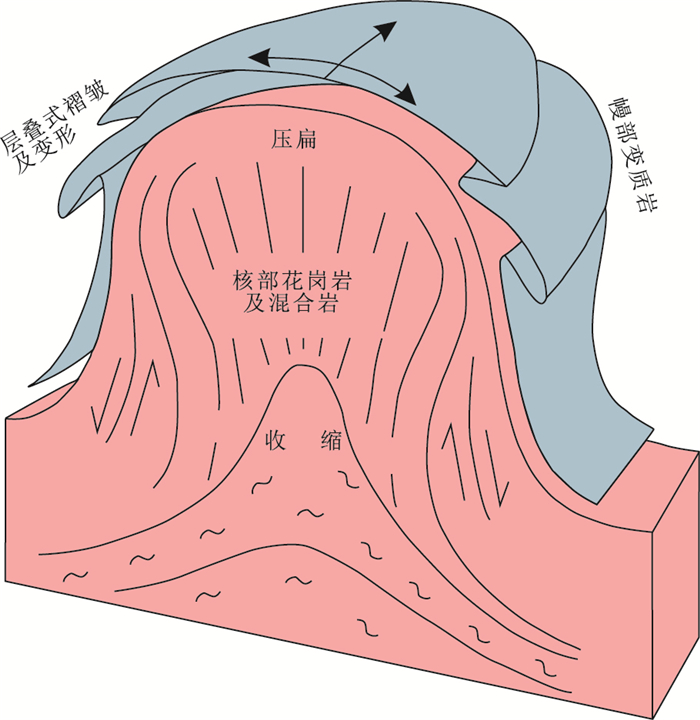
 下载:
下载:
